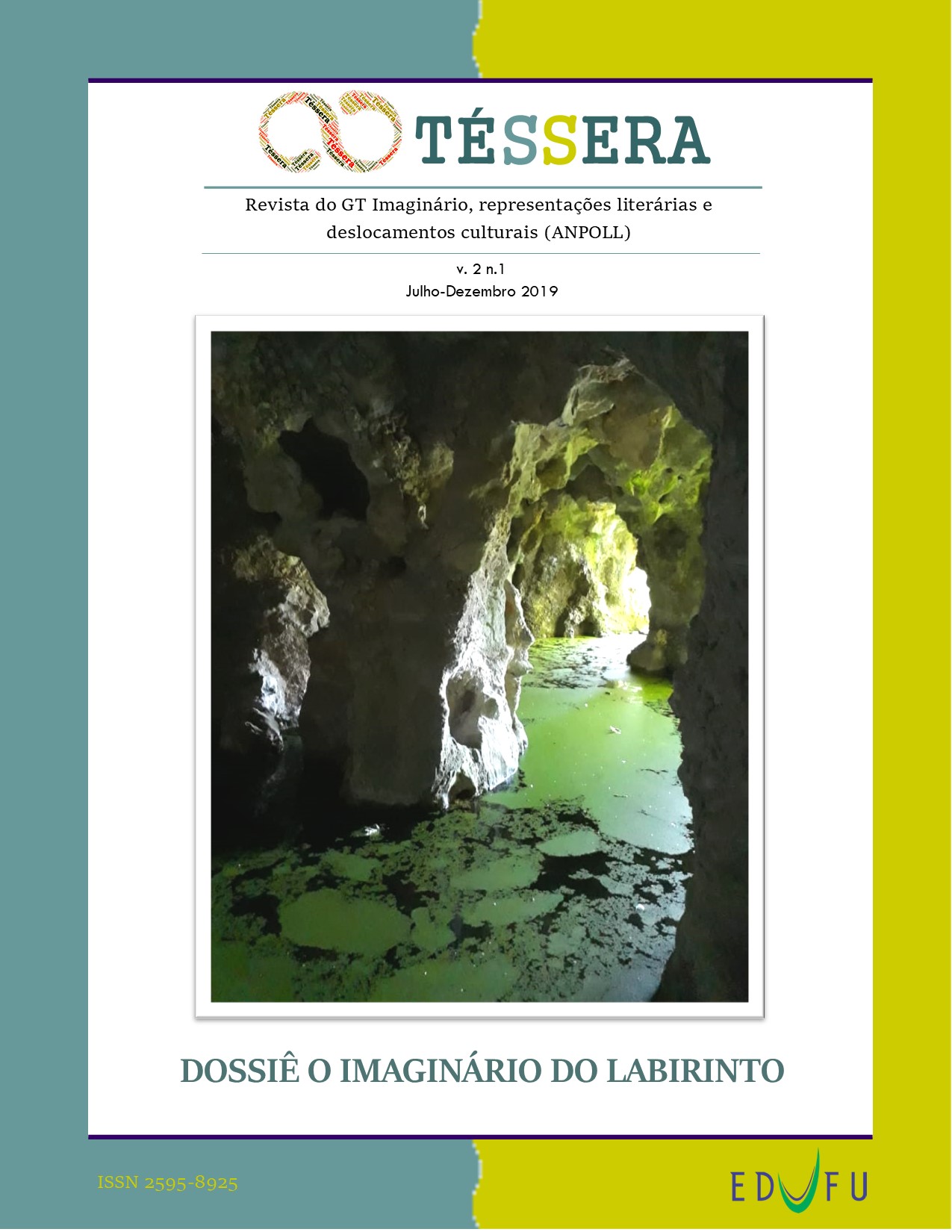KNOWLEDGE AS FORBIDDEN FRUIT IN THE THE NAME OF THE ROSE’S LABYRINTHINE LIBRARY
DOI:
https://doi.org/10.14393/TES-v2n1-2019-51195Keywords:
The Name of the Rose, labyrinth, GenesisAbstract
By drawing a parallel between the forbidden fruit of Genesis and the forbidden book of Umberto Eco's The Name of the Rose (1980), this paper proposes an interpretation – aware that there are several other possible ones – to the labyrinthine library portrayed in the novel. Amid the confrontation between monks who yearn for access to knowledge and monks who forbid such access, judging it dangerous, one can see in the abbey created by Eco allusions to the fall of Adam and Eve, who are expelled from Eden for experiencing the fruit of the tree of the knowledge of good and evil. Based on the study of symbols (BIEDERMAN, 1992; CIRLOT, 2001; FERBER, 2007; TRESSINDER, 2012), considerations about the biblical founding myth (COTTER, 2003; TOWNER, 2001) and explanations about the labyrinth provided by the author himself (1985; 2017), it seeks to investigate relationships between prohibition, authority and knowledge in the book’s context.
References
BAXTER, David G. “Murder and Mayhem in a Medieval Abbey: The Philosophy of The Name of the Rose”. The Journal of Speculative Philosophy 3, n. 3, 1989, p. 170-89.
BIEDERMAN, Hans. Dictionary of symbolism: cultural icons and the meanings behind them. Tradução para o inglês de James Hulbert. Nova York / Oxford: Facts on File, 1992.
CIRLOT, J. E. A dictionary of symbols – second edition. Traduzido do espanhol por Jack Sage. Londres: Routledge, 2001.
COTTER, David W. Genesis (Berit Olam: Studies in Hebrew Narrative & Poetry). Collegeville (Minnesota): The Liturgical Press, 2003.
DELEUZE, Gilles; GUATTARI, Félix. Mil platôs: capitalismo e esquizofrenia. Vol. 1. Tradução de Aurélio Guerra Neto e Celia Pinto Costa. São Paulo: Editora 34, 2000.
ECO, Umberto. De bibliotheca (I Quaderni de Palazzo Sormani, 6 – Comune di Milano, 1981). Tradução de Ana Lúcia S. Labigalini, Cesar Casella, Flora Mariottini e outros. Campinas: Unicamp, 2004. Disponível em: https://www4.iel.unicamp.br/biblioteca/arquivos/Eco_Umberto_De_Bibliotheca.pdf. Acesso em 15 out. 2019.
ECO, Umberto. Obra aberta. Tradução de Giovanni Cutolo. São Paulo: Perspectiva, 1991.
ECO, Umberto. O nome da rosa. Tradução de Aurora Fornoni Bernardini e Homero Freitas de Andrade. Rio de Janeiro: Record: 2017.
ECO, Umberto. Reflections on The Name of the Rose. Londres: Secker & Warburg, 1985.
FERBER, Michael. A dictionary of literary symbols – second edition. Nova York: Cambridge University Press, 2007.
GARRETT, Jeffrey. “Missing Eco: On Reading ‘The Name of the Rose’ as Library Criticism”. The Library Quarterly: Information, Community, 4, 1991, p. 373-388.
GÊNESIS. Tradução de Alexandro Zir. Porto Alegre: L&PM, 2001.
GUIMARÃES, Denise Azevedo Duarte. “A Idade Média revisitada por Umberto Eco”. Letras, Curitiba, n. 37, p. 208-223
HAFT, Adele J.; WHITE, Jane G.; WHITE, Robert J. The Key to ‘The Name of the Rose’: including translations of all non-English passages. Ann Arbor (MI): University of Michigan Press, 1999.
HARTOG, François. O espelho de Heródoto – ensaio sobre a representação do outro. Tradução de Jacyntho Lins Brandão. Belo Horizonte: UFMG, 1999.
KURY, Mário da Gama. Introdução. In: SÓFOCLES. A trilogia tebana: Édipo Rei, Édipo em Colono, Antígona. Rio de Janeiro: Zahar, 2011.
SWAIM, Kathleen M. “The Art of the Maze in Book IX of Paradise Lost”. Studies in English Literature, 1500-1900 12, n. 1, 1972, p. 129-40.
TERZIEVA-ARTEMIS, Rossitsa. “The Name of the Rose and the Labyrinths of Reading”. In: BLOOM, Harold; HOBBY, Blake (Ed.) Blooms’s Literary Themes: The Labyrinth. Nova York: Bloom’s Literary Criticism (Infobase Publishing), 2009). p. 173-184.
TOWNER, W. Sibley. Genesis. Louisville: Westminster John Knox Press, 2001.
TRESSIDER, Jack. The Watkins dictionary of symbols. Londres: Watkins Publishing, 2012.
VOGL, Joseph. Ein Labyrinth ohne Anfang und Ende. Was ist ein RHIZOM? Disponível em: https://www.dctp.tv/filme/prime-time-30-09-2007. Acesso em 15 out. 2019.
Downloads
Published
Issue
Section
License
Authors who publish in this journal agree to the following terms:
Authors retain the copyright and waiver the journal the right of first publication, with the work simultaneously licensed under the Creative Commons Attribution License (CC BY-NC-ND 4.0), allowing the sharing of work with authorship recognition and preventing its commercial use.
Authors are authorized to take additional contracts separately, for non-exclusive distribution of the version of the work published in this journal (publish in institutional repository or as a book chapter), with acknowledgment of authorship and initial publication in this journal.


